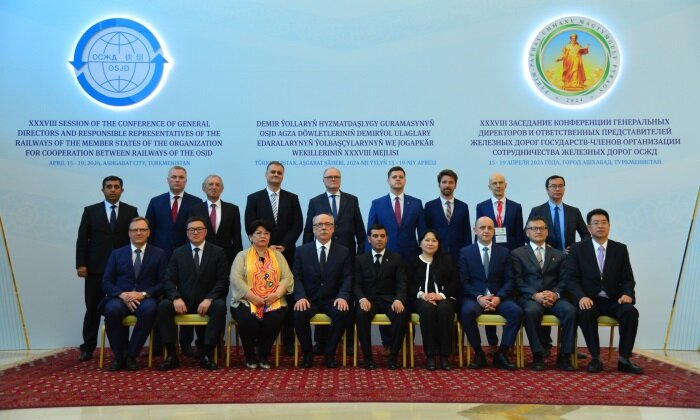The two-chamber structure of parliament will allow combining certain functions and areas of activity, both lawmaking, and representative.
 Within an exclusive interview political analyst of the online media CentralAsia.news, Doctor of Law, Professor, Honored Lawyer, and Honorary Elder of Turkmenistan Murad Khaitov explained the importance of reforming the constitution of Turkmenistan, which is associated with the formation of a bicameral parliament, and the adaptation of the Basic Law to the concerns of new challenges of today.
Within an exclusive interview political analyst of the online media CentralAsia.news, Doctor of Law, Professor, Honored Lawyer, and Honorary Elder of Turkmenistan Murad Khaitov explained the importance of reforming the constitution of Turkmenistan, which is associated with the formation of a bicameral parliament, and the adaptation of the Basic Law to the concerns of new challenges of today.
Murad Ovezberdiyevich, what are the premises for the parliamentary reform?
— The changes taking place in the political system recently have inevitably led to the rising of the question on amending the Constitution of Turkmenistan, bringing public institutions of power to a new level. It is indeed the most important historical moment. In fact, with the formation of a bicameral parliament, an additional system of checks and balances is introduced within the exercise of legislative power. Today the effectiveness of the functioning of public authorities in the context of the political modernization of Turkmenistan largely depends on the constitutional principles of their organization incorporated into the activities of the institutions of representative democracy.
Did the etymology of the Turkmen state influence it?
— The revival of parliamentarism in Turkmenistan is associated with the formation and activities of the bicameral national parliament of Turkmenistan. Its formation as a national legislative body is the main goal and purpose of modern parliamentary reform. The historical uniqueness of the experience of domestic parliamentarism is also demonstrated by the fact that the improvement of national statehood is carried out taking into account the traditions of our national continuity and mentality. Many years of experience in organizing popular representation, the national-territorial model of the state, the need to improve legal and parliamentary culture, have also affected the formation of modern parliamentarism.
The draft Constitutional Law prepared by the working group of the Mejlis states that «the parliament is a representative body exercising legislative power in Turkmenistan». What does it mean?
— The constitutional characteristic means that on the one hand, the National Council — parliament (a single body) will fulfill both representative and legislative functions. The representative function of parliament should be understood as the National (People’s) Council and a nationwide forum, which is supposed to openly and publicly discuss the most important issues of the state and public life of the country.
On the other hand, parliament is a legislative body and its activities are exclusively aimed at adopting laws. Thus, in the constitutional characteristic, there is an organic combination of two interrelated functions in one (single) body at the same time — representative and legislative.
The National Council of Turkmenistan (parliament) is formed as a nationwide body. To implement these functions, two independent chambers are formed — the Halk Maslahaty and the Mejlis. The constitution establishes their exclusive powers. Other powers beyond the constitutional framework will be provided by the current law and the regulations of the chambers. Thus, constitutional «rationalization» will allow to optimally determine the sphere of jurisdiction of each chamber, taking into account the role, place, and importance in the structure of parliament.
What is the role of the Halk Maslahaty?
— Firstly, the Halk Maslahaty is not the «supreme» or «superior» state body. As a parliamentary institution, the Halk Maslahaty is one of the chambers of the national parliament. The Chamber, in turn, as part of a single parliamentary body, is a «part» of the «separation of powers» mechanism that currently exists in Turkmenistan.
Secondly, the Halk Maslahaty is neither the «upper» nor the «lower» chamber of parliament.
Thirdly, the Halk Maslahaty is not a superior body concerning the local representative bodies of state power with respect to the Halk Maslahaty of Ashgabat, velayats (provinces), etraps (districts), and cities. The Constitution of Turkmenistan has abandoned the principle of the unity of the system of representative bodies of state power. Accordingly, local representative bodies of state power do not have hierarchical subordination among themselves, as well as between parliament, both vertically and horizontally.
Fourthly, the order of formation of the Halk Maslahaty is also significantly different. For example, the draft Constitutional Law provides for a mixed procedure for the formation of the Halk Maslahaty according to certain quotas (norms of representation from territories and persons appointed by the President of Turkmenistan). Consequently, the Halk Maslahaty is the spokesman for the interests of the territories and the population, acts as a body that gathers specialists with special knowledge, political and professional experience.
Fifth, the organizational division of the chambers of the national parliament is also manifested in the fact that they function in separate sessions. However, in exceptional cases, parliamentary chambers can also convene joint sessions, for example, to hear messages from the President of Turkmenistan, speeches by heads of foreign states, and international organizations. In some cases, at the initiative of the President of Turkmenistan, in order to discuss the most important issues of the state and public life of the country with the participation of representatives of the public, joint sessions of the chambers can be held.
And finally, the Halk Maslahaty, along with the Mejlis, exercises legislative powers. Its role in the legislative process is that it approves the laws passed by the Mejlis, or rejects them. To approve the bill, 50% of the votes of the members of the Halk Maslahaty are required. Consequently, giving the Halk Maslahaty the right to reject the law means exercising not only legislative but also control functions concerning the laws adopted by the Mejlis.
Has there been a similar situation with reforming a legislative body in the history of modern Turkmenistan?
— Almost three decades after the proclamation of independence and the adoption of the Constitution of a sovereign state Turkmenistan has reformed the structure of the national parliament for the first time. And here it is important to note that the parliamentary reform was initiated by the President of Turkmenistan Gurbanguly Berdimuhamedov.
The combined structure of the national parliament will organically combine certain functions and areas of activity, both lawmaking and representative. It is designed to express the interests of the population and carry out legislative work.
The work of the bicameral parliament will be carried out not only in the implementation of its main and direct function — the implementation of legislative activity but also in the implementation of parliamentary control over the adopted laws. At the same time, the members of the body will participate in government events aimed at consolidating the nation, forming a single national idea.





